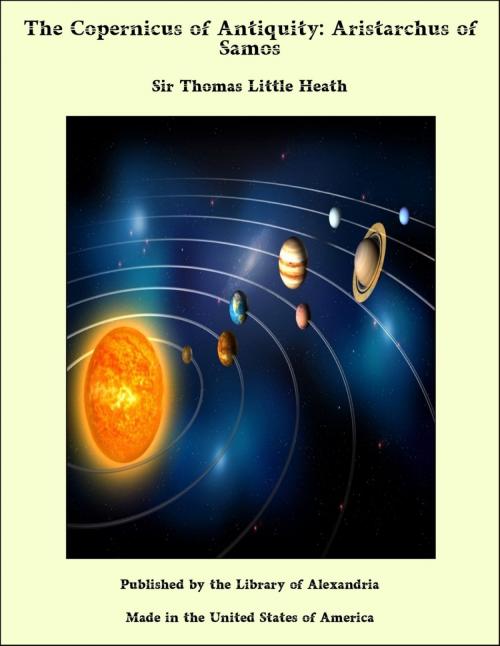The Copernicus of Antiquity: Aristarchus of Samos
Nonfiction, Religion & Spirituality, New Age, History, Fiction & Literature| Author: | Sir Thomas Little Heath | ISBN: | 9781465624000 |
| Publisher: | Library of Alexandria | Publication: | March 8, 2015 |
| Imprint: | Language: | English |
| Author: | Sir Thomas Little Heath |
| ISBN: | 9781465624000 |
| Publisher: | Library of Alexandria |
| Publication: | March 8, 2015 |
| Imprint: | |
| Language: | English |
The title-page of this book necessarily bears the name of one man; but the reader will find in its pages the story, or part of the story, of many other Pioneers of Progress. The crowning achievement of anticipating the hypothesis of Copernicus belongs to Aristarchus of Samos alone; but to see it in its proper setting it is necessary to have followed in the footsteps of the earlier pioneers who, by one bold speculation after another, brought the solution of the problem nearer, though no one before Aristarchus actually hit upon the truth. This is why the writer has thought it useful to prefix to his account of Aristarchus a short sketch of the history of the development of astronomy in Greece down to Aristarchus’s time, which is indeed the most fascinating portion of the story of Greek astronomy. The extraordinary advance in astronomy made by the Greeks in a period of little more than three centuries is a worthy parallel to the rapid development, in their hands, of pure geometry, which, created by them as a theoretical science about the same time, had by the time of Aristarchus covered the ground of the Elements (including solid geometry and the geometry of the sphere), had established the main properties of the three conic sections, had solved problems which were beyond the geometry of the straight line and circle, and finally, before the end of the third century B.C., had been carried to its highest perfection by the genius of Archimedes, who measured the areas of curves and the surfaces and volumes of curved surfaces by geometrical methods practically anticipating the integral calculus. To understand how all this was possible we have to remember that the Greeks, pre-eminently among all the nations of the world, possessed just those gifts which are essential to the initiation and development of philosophy and science. They had in the first place a remarkable power of accurate observation; and to this were added clearness of intellect to see things as they are, a passionate love of knowledge for its own sake, and a genius for speculation which stands unrivalled to this day. Nothing that is perceptible to the senses seems to have escaped them; and when the apparent facts had been accurately ascertained, they wanted to know the why and the wherefore, never resting satisfied until they had given a rational explanation, or what seemed to them to be such, of the phenomena observed. Observation or experiment and theory went hand in hand. So it was that they developed such subjects as medicine and astronomy. In astronomy their guiding principle was, in their own expressive words, to “save the phenomena”. This meant that, as more and more facts became known, their theories were continually revised to fit them.
The title-page of this book necessarily bears the name of one man; but the reader will find in its pages the story, or part of the story, of many other Pioneers of Progress. The crowning achievement of anticipating the hypothesis of Copernicus belongs to Aristarchus of Samos alone; but to see it in its proper setting it is necessary to have followed in the footsteps of the earlier pioneers who, by one bold speculation after another, brought the solution of the problem nearer, though no one before Aristarchus actually hit upon the truth. This is why the writer has thought it useful to prefix to his account of Aristarchus a short sketch of the history of the development of astronomy in Greece down to Aristarchus’s time, which is indeed the most fascinating portion of the story of Greek astronomy. The extraordinary advance in astronomy made by the Greeks in a period of little more than three centuries is a worthy parallel to the rapid development, in their hands, of pure geometry, which, created by them as a theoretical science about the same time, had by the time of Aristarchus covered the ground of the Elements (including solid geometry and the geometry of the sphere), had established the main properties of the three conic sections, had solved problems which were beyond the geometry of the straight line and circle, and finally, before the end of the third century B.C., had been carried to its highest perfection by the genius of Archimedes, who measured the areas of curves and the surfaces and volumes of curved surfaces by geometrical methods practically anticipating the integral calculus. To understand how all this was possible we have to remember that the Greeks, pre-eminently among all the nations of the world, possessed just those gifts which are essential to the initiation and development of philosophy and science. They had in the first place a remarkable power of accurate observation; and to this were added clearness of intellect to see things as they are, a passionate love of knowledge for its own sake, and a genius for speculation which stands unrivalled to this day. Nothing that is perceptible to the senses seems to have escaped them; and when the apparent facts had been accurately ascertained, they wanted to know the why and the wherefore, never resting satisfied until they had given a rational explanation, or what seemed to them to be such, of the phenomena observed. Observation or experiment and theory went hand in hand. So it was that they developed such subjects as medicine and astronomy. In astronomy their guiding principle was, in their own expressive words, to “save the phenomena”. This meant that, as more and more facts became known, their theories were continually revised to fit them.















